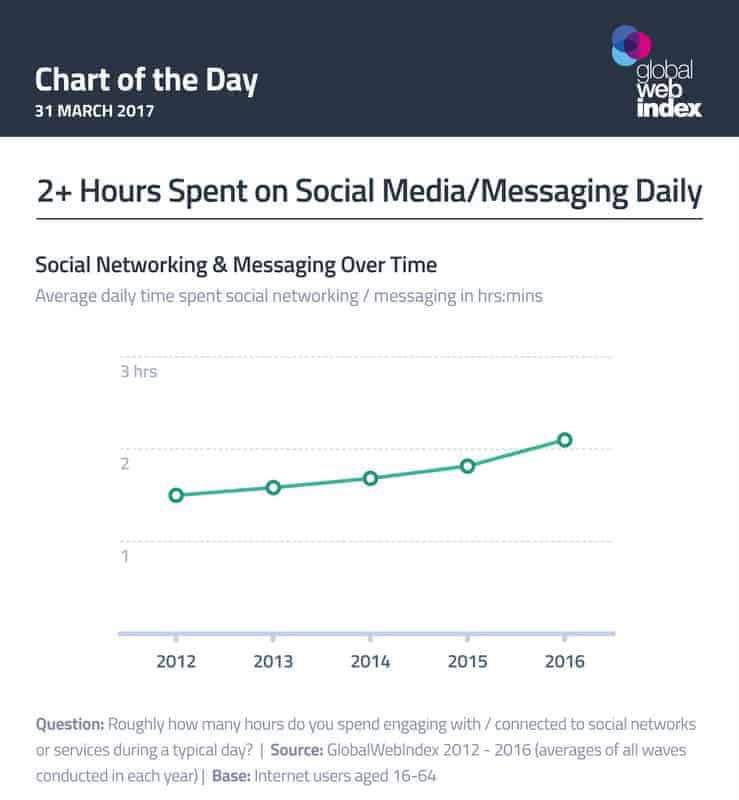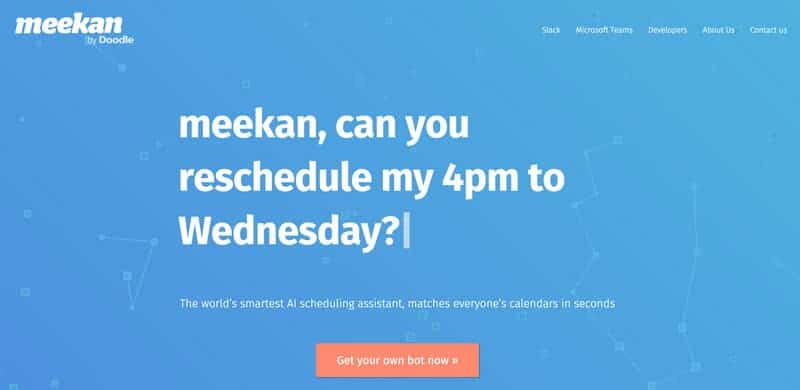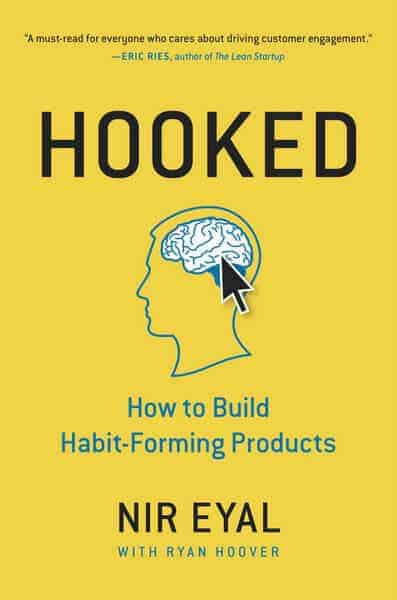What is your relationship with your phone? How much screen time do you have each day?
If you're worried about how high the number is, you're not alone.
According to a Global Web Index report the average person is now spending over 2 hours a day scrolling, liking, sharing, and messaging:

In just over a decade, the way we live, work, and communicate has transformed significantly.
The Internet, smartphones, and social media have all improved our lives in a variety of ways. However, it hasn't been all positive.
The effects of tech on our well-being
The accessibility of smartphones, incessant notifications, and the addictive nature of social media are constant sources of distraction and overwhelm.
It's still too early to know for certain how all this new tech affects us. However, several studies have shown that excessive device use and time on social is clearly bad for us:
- The blue light our devices give off can negatively impact your sleep quality (especially 2-3 hours before bed), as Harvard Health summarized.
- A PLOS One study found that regular social media use reduces your self-esteem and general well-being.
- Another published in Computers in Human Behavior found that social media use increases anxiety.
- And another found "the more you use Facebook over time, the more likely you are to experience negative physical health, negative mental health and negative life satisfaction,” according to study author Holly Shakya or the University of California, San Diego.
As a manager, you're an example to your team. Your relationship with technology not only affects you, but also can influence how your team does. Let's make sure you're a good example for them.

It's about better tech-habits
No matter how much you may feel like it sometimes, you can't throw your phone away. It has many benefits, making our lives easier, better, and more convenient.
Instead, the key is being intentional about your habits with your phone and other technology.
Social media, chat apps, and other new technology are all double-edged swords. They can be great tools, but they can also suck you dry and leave you stressed, distracted, and emotionally hollow.
To create a healthier relationship with technology, it's important to look at what your habits are now and make detoxing a real priority.
No one's asking you to get off social and it's unrealistic for any professional to give up their smartphone. However, there are things you can do to manage your technology use, hit the reset button, and establish new and better tech-habits moving forward.
Table of Contents:
- Manage your notifications
- Distance yourself from toxicity
- Be part of the solution: Make time to curate, create, and share the positive

How to create a healthy relationship with technology
There's a lot of advice out there that suggests you drop your smartphone and take a break. They say that this will help you hit reset for good and everything will be perfect.
Taking a break is important. You need to gain some perspective so you can see how that technology is affecting you. Awareness is key, but it's not enough. Breaks don't fix the issues that caused you to need time away.
You need to find the real root causes and make adjustments to deal with the source of the problem. By doing that, you can take all the positive from your devices, social, and other digital time without as much downside.
By doing so, you'll be setting the example for the rest of your team who are likely having the same challenges with their tech use as you.
Here's how to create a healthy relationship with technology:
1. Manage your notifications
Notifications might be the most challenging part of modern technology.
We want to know when someone messages us, and it's fun to find out about likes, retweets, breaking news, and crime near us. However, each of those unique, little chimes that each app uses to tell us something happened is a constant source of distraction.
Smartphones really make these little notifications difficult. It's easy to pick up your phone in the middle of a meeting to check who messaged you on Slack or Whatsapp, or see what that buzz was all about.
And while you're writing an email or in the middle of work? What are two short minutes to check your messages?
No harm done, right?
Not quite. According to a study published by Gloria Mark of the University of California, Irvine, it takes about 23 minutes to get your focus back to what it was on a pre-existing task when you've become interrupted.
Even a short 2-minute interruption can completely derail you and reduce your productivity every time you're distracted. This means if you have a lot of notifications turned on, and you're distracted like that every 10-30 minutes, you may never reach complete focus to do high-quality, deep work.

Multitasking is unproductive
Constant notifications also cause you to multitask more often than ever before. Every time you pick up the phone while you're in a meeting, listening to a call, or doing other work, you're pushing your brain to multi-task.
Of course, it's seductive to multitask. After all, we want to be productive and we feel productive while multitasking. You want to be that super responsive boss, who your team can always get an answer from. But at what cost?
Several studies, including one published in the Journal of Experimental Psychology have found that multitasking actually makes you less productive. Compounding things, a Harvard study found that this kind of split attention can make you less happy as well.
Resist the temptation to multi-task and you'll find you can focus more deeply, and get more done. You'll also be setting a key example for your team, so that they can also have more focused, uninterrupted time.
Dial down your notifications.
To take control of these distractions, you need to be intentional about your notifications.
First, skim through your app notifications and stop notifications for any non-messenger apps you just don't need. Chances are there's quite a few that pop up frequently and are a complete waste of your attention.
Ask yourself: Can the "breaking news" wait until you're taking a break or eating lunch? Does it matter when someone liked your photo on Instagram, or can it wait until after work? Chances are, many of them aren't really that urgent.

Sometimes, you can't turn the notifications off. For instance, if you use Slack or another chat tool at work, you do need to see messages from your team.
However, you can use a tool like Meekan to change your status to away on apps like Slack during meetings and control when you get notifications.
Whether you use a tool or do this manually, the idea is that you decide when your phone shows you notifications, and importantly, when to tell it, "Nope, it's focus time.”
Another helpful rule to apply is to be intentional about when you keep your phone out (and on) versus when you put it away so you can focus. If your phone is in your purse, bag, or at your desk during an important meeting, it can't buzz and pull you out of an important moment.
When you're working on something that demands your full attention, consider placing your phone out of the way; put it in a bag, in your desk, or simply in airplane mode for a bit.

2. Distance yourself from toxicity
As we touched on earlier, social media is the greatest challenge when it comes to our devices.
Social media has been found to have a real impact on our mental well-being, so you need to be intentional about more than just when you receive notifications. You need to control what you see when you scroll as well.
The challenge is social media sites are designed to encourage their use without us even realizing it. Often, we end up flipping through social on a whim before realizing 30 minutes have gone by.
You might not even remember what you were looking at.
The positive, the negative– and often lots of it– it all just becomes noise that feeds into our subconscious.
Be more conscious and intentional about how you interact with social and distance yourself from the negativity. Is the latest outrage about the other political party really worth poisoning your mood for the rest of the day?
The power of persuasion
Whether you realize it or not, your world is constantly trying to persuade you.
The bright red of that stop sign on your way home is colored like a signal for danger. That perfect sparkling bowl of cereal on every cereal box when you visit the supermarket is meant to spark your appetite. And those soothing chimes, pretty little app icons, and satisfying designs are meant to hook you on social.
These are normal kinds of persuasion that we've all come to accept. They're useful for helping drawing our attention momentarily.
The only problem is, social networks have taken this persuasion to a different level.

In Hooked: How to Build Habit-Forming Products, author Nir Eyal explains that there are two kinds of psychological manipulation:
- Persuasion: Where you get someone to do something they want.
- Coercion: Where you get someone to do something they don't want to do.
Persuasion is the red stop sign or the bowl of cereal. Coercion is forceful and unethical.
Clearly, social media isn't coercion. But those and other smartphone apps have been criticized for using such persuasion techniques to monopolize our attention in a way that is close to it:
If you aren't careful, social media apps will often send you through a wash cycle of negativity before you even realize what hit you.
Not only, then, is it eating up large portions of your time but it's also often a source of constant negativity.
Take control of your feeds
Awareness is an important part of managing your relationship with technology. If you don't know how it's affecting you, you can't do much about it.
But there's another way you can fight against these strong persuasive design strategies: by controlling what shows up in your feed in the first place.
Take some time to look at who you follow on all your accounts and why. If you hate Trump or Biden, does it do you any good to follow them? What are you getting from reading a couple of tweets every day you know will make you furious?
Do you follow someone that you like but only seems to use their exposure to complain about their life or politics?
Consider taking these steps to reduce or distance yourself from toxicity on social:
- Unfollow toxic accounts if you can (personality, acquaintance you don't need to follow)
- Mute/Block accounts and topics that you realize don't add value to your life.
- Use "Show this less often” when it's an option for ads and posts.
- And "Like” or thumbs up to show that you like something and want to see more of it when it's positive or of value.
Just like pulling weeds makes for a better, healthier garden, a little maintenance on your social media accounts can make a big difference in your happiness and value you get from them.
3. Be part of the solution: Make time to curate, create, and share the positive
So far, we've talked a lot about the negative side of tech and social. But we don't just want to avoid the negative. There's a big positive side to it and you want to make use of that as well. (After all, a positive outlook makes you a better leader.)
Several studies have found that social has the ability to make us happier in the right circumstances, especially for those who might otherwise be physically isolated from others. This makes social media particularly useful for remote employees, who are prone to loneliness from isolation.
One study found that microblogging, including regular short updates on social, can help reduce negative emotions and boost your mood:
Ultimately, social media is what you make of it. Your feed can be filled with negativity, making you the willing victim sucked into the vortex once or twice a day. On the other hand, you can be a more intentional participant by designing your feed for positivity and value.
Think of your social feed as an apartment and Marie Kondo just walked in. Who of your many followers, and their social posts, spark feelings of joy in you? (Just, whatever you do, don't give away the socks.)
Value might be a more accurate metric than joy, but you get the idea. Think of your list of followers, and your feed, as a list that you yourself curate. You control what you see. Make everything, or as much as possible, that goes through your feed of positive value to you. Whatever doesn't, if you haven't already, consider getting rid of it.
There are plenty of great people to follow on various accounts that will help you learn, grow, reflect, see the good in the world, or stay in touch with someone you care about. Focusing on those is a great way to make it a healthy part of your life.
Friday work tip:
— Mike Coutermarsh (@mscccc) October 12, 2018
Before the weekend. DM one coworker who impressed you this week. Let them know.
Take time to create and share good
If you have much of a social presence publicly, it's likely your team or some colleagues follow you. If that's the case, you can set a great example for them by positive positive things as well.
In fact, using social to give out praise to your team can make you happier as well.
A simple exercise dubbed "3 Good Things” by psychologists Martin Seligman, Tracy Steen, Nansook Park, and Christopher Peterson has been found to boost happiness long-term.
The exercise involves writing down three things you're grateful for that day or week and writing them down. You can adapt that exercise for your team by asking questions such as:
- Whose efforts on your team are you most grateful for?
- Who really went above and beyond this week?
- What habit or action does your team have that you really appreciate?
Take those answers and send a quick message to those 3 team members or colleagues. You'll not only boost your own mood but make their week as well.
*Further reading: To learn more about how to give effective praise and be more positive, read: The Ultimate Workplace Praise Guide: How to be More Positive at Work and Give More Praise to Your Team.
Positivity is contagious
Remember: You can share more than positive words to your team. You can share anything positive of value that you believe your team and others following you could gain value from.
That could be an:
- Interesting article
- Thought-provoking interview
- A great book you read
- A quote that inspires you
- Or details of an event you're excited about or enjoyed
Research published in PLOS One from the University of California, San Diego found that positive social posts actually encourage the spread of more positive posts from other users. You really can be the change you want to see in the world.
The study found that for every positive post, nearly 2 more positive updates or posts were made by users who saw their post. According to lead study author James Fowler, professor of political science at the School of Medicine at UC San Diego:
"Our study suggests that people are not just choosing other people like themselves to associate with, but actually causing their friends' emotional expressions to change."
No matter what you decide to share or how you choose to bring more positivity to your social activity, keep in mind that a little positivity is powerful. Not just for you but for your team and everyone around you as well.
Control your relationship with technology – don't let it control you
As a manager, you influence the behavior of those around you, especially your team.
Technology is an inseparable part of most of our lives, so rather than avoid it, embrace the opportunity.
Taking a break from time to time is useful. But, at the end of the day, you have to face the issue. It takes work to manage your tech use. But you can make a big difference in your life and moods by:
- Managing your notifications
- Distancing yourself from toxicity on social, and
- Making time to create, curate, and share positivity
By doing so, you'll not only better manage your social use better, but set an example that increases productivity and positivity for those around you as well.
And if you're not sure where to start, apps like Moment can monitor your smartphone or other device usage and inform you of your usage habits. With that information in hand, you'll know what tools and apps are your real problem area and can focus in on that first.
Awareness is the most important part of creating a healthy relationship with technology.
Before you can solve the problem or make any change you need to know what's wrong. Start paying attention to how you use your phone, your computer, social, and how they make you feel.
That alone can give you all the information you need to make a positive change and lay the groundwork for your team to do the same.
Do you have control of your phone and technology habits, or does they control you?





